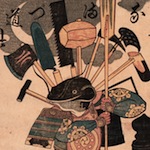|
RC and Moon Pie posted:Kinda scary, though, that when Rae went looking and mapped a good bit of northwest Canada, some of Franklin's men might have still been alive. Particularly Crozier. There's at least one piece of Inuit testimony of either an encounter with or sighting from a distance of two members of the expedition (one of whom is believed to have been Crozier) wandering about 250 miles or so to the south of where they would have come ashore on mainland Canada some time in the mid-1850s, potentially as much as 10 years after the Erebus and the Terror became trapped in the ice. A cairn which confirmed this to be the case was finally discovered in 1948.
|
|
|
|

|
| # ? May 30, 2024 05:18 |
|
Fun Historical Fact: During the search after Franklin's expedition people surveyed more of the Arctic than Franklin could ever have done. Scott's doomed expedition also helped prove Gondwanaland-theory. He found fossils of plants that also was found in South-America, Australia and Africa. Of course making the detour to find the fossils and then insisting on hauling them back to the base was probably one of the factors that caused him and the rest to die. Alhazred has a new favorite as of 21:16 on Dec 26, 2016 |
|
|
|
|
Wheat Loaf posted:There's at least one piece of Inuit testimony of either an encounter with or sighting from a distance of two members of the expedition (one of whom is believed to have been Crozier) wandering about 250 miles or so to the south of where they would have come ashore on mainland Canada some time in the mid-1850s, potentially as much as 10 years after the Erebus and the Terror became trapped in the ice. A cairn which confirmed this to be the case was finally discovered in 1948. If I may quote myself from the "PYF unnerving" thread: BalloonFish posted:One of the aspects of the Franklin expedition that I've always found most unnerving is when you piece together all the Inuit oral histories and contemporary reports you get a picture of little groups of Europeans surviving for years after the expedition itself was 'lost', crawling around the Canadian Arctic in a vain attempt to reach civilisation hundreds of miles away while suffering starvation, scurvy, lead poisoning and hypothermia. Some were taken in by Inuit for months and restored to some sort of health before setting out once more, never to be seen again. Others reportedly died in their harnesses hauling heavily-laden boats mounted on sledges, or scared off would-be helpers with the ferocity that they fought over scraps of meat offered to them. These reports go into 1851 and there are graves and fragmentary remains of camps and abandoned equipment scattered all over Wager Bay, King William Island, the Meville Peninsula and even into the northwest of Hudson Bay. Alhazred posted:Fun Historical Fact: Both the Nimrod and Terra Nova expeditions brought back samples of coal from Antarctica, further proving that the continent was once covered in plant life. When Shackleton was fund-raising for his Imperial Trans-Antarctic Expedition one way he did it was to propose the whole thing as a business venture - that by being the first team to cross (and claim) Antarctica British business would have access to a brand new source of the world's most important fuel. Given that Shackleton would do or say almost anything in order to be given a cheque so he could afford to do more exploring in the frozen south it's doubtful he ever seriously believed that Antarctic coal mining was practical, but he obviously managed to convince a few people that it was! And on the subject of the ITAE - the Weddell Sea party (led by Shackleton on the Endurance) is only the famous half of a two-part expedition. At the same time a party went to the Ross Sea on the Aurora to lay depots and set up a camp to receive the trans-Antarctic party (which of course never landed on Antarctica, let alone crossed it). In the winter of 1915 (when Endurance was already irretrievably locked in the ice on the other side of the continent) the Aurora was blown free of her moorings in a gale and then became trapped in sea ice herself, which then drifted out to sea taking most of the personell and supplies with her. Aurora drifted north for nine months and nearly 1600 miles before the ice melted and the badly-damaged ship was able to reach New Zealand before being patched up and returned to the Ross Sea to pick up the people left behind - who had dutifuly but pointlessly laid depots with what supplies they had left.
|
|
|
|
I dunno if it's been mentioned in this thread, but the original Nimrod was a biblical king who's supposed to be a great hunter. But ever since Bugs Bunny called Elmer Fudd Nimrod ironically, it pretty much means dumbass.
|
|
|
|
one time the god Dionysus said he'd gently caress a dude but the dude died before he got around to it so he carved a wooden dildo, put it on the dude's tomb, and sat on it vow: fulfilled
|
|
|
|
InediblePenguin posted:one time the god Dionysus said he'd gently caress a dude but the dude died before he got around to it so he carved a wooden dildo, put it on the dude's tomb, and sat on it badass
|
|
|
|
I imagine it was afterwards
|
|
|
|
Ichabod Sexbeast posted:I imagine it was afterwards Once in every thousand years a post, username and avatar align perfectly.
|
|
|
|
A sixteenth century "garden designer" was probably a spy: https://www.theguardian.com/education/2016/dec/26/cambridge-student-discovers-hidden-life-renaissance-spy posted:Something odd emerged as a Cambridge student began to research the work of a Renaissance garden designer: although the 16th century Italian artist, sculptor and designer Costantino de’ Servi travelled constantly and never seemed to be short of a bob, he seemed to have completed very few gardens - or any other kind of work.
|
|
|
|
The founder of mga-luxury brand Versace, Gianna Versace, was killed by a serial killer. Just one of those things.
|
|
|
|
Hairdresser Vidal Sassoon used to fight nazis for fun just after WW2
|
|
|
Ichabod Sexbeast posted:Hairdresser Vidal Sassoon used to fight nazis for fun just after WW2 And Coco Chanel fought for the Nazis, which we didn't find out until a biographer a few years ago uncovered declassified documents revealing her status as a spy, code name "Westminster". The SS intended for her to try and convince Churchill to negotiate a peace treaty. She even used her Aryan status to seize 100% control of Chanel profits when all Jewish-owned businesses were seized, since the Jewish directors of Parfums Chanel got ousted. And she managed to completely avoid any kind of punishment, possibly because she may expose some Nazi sympathizers in the British government if put on trial, and spent the remaining decades of her life wealthy and successful. It would take 40 years after her death for Hal Vaughn's biography to reveal the contents of the declassified documents to the world.
|
|
|
|
|
OG fashion was pretty cutthroat
|
|
|
|
Ichabod Sexbeast posted:OG fashion was pretty cutthroat Hugo Boss agrees.
|
|
|
|
Sorry to dredge up last page but why exactly is the imitation game bad? What did it do wrong by Turing?
|
|
|
|
Wikipedia has a decent list of the inaccuracies. https://en.wikipedia.org/wiki/The_Imitation_Game#Accuracy Most of it seems to be exaggerating Turing's slight awkwardness into full-blown autism (which he almost certainly did not have), and general historical inaccuracies about how things worked at Bletchley.
|
|
|
|
In 1925 Percy Fawcett and his eldest son went missing in the Amazonian forest in his search for "Z", which he believed was Eldorado. More people have died searching for Fawcett than people searching for Eldorado.
|
|
|
|
|
Sweevo posted:Wikipedia has a decent list of the inaccuracies. https://en.wikipedia.org/wiki/The_Imitation_Game#Accuracy E: I wouldn't quite call it my favourite historical fact, but an interesting one, and ignored by the movie, is that Turing's work built largely on previous extremely ingenious Polish attempts to decrypt Enigma. The name for (one of) the deciphering machines Turing built - Bombe - even comes from polish Bomba. Cingulate has a new favorite as of 18:08 on Dec 28, 2016 |
|
|
|
Sweevo posted:Wikipedia has a decent list of the inaccuracies. https://en.wikipedia.org/wiki/The_Imitation_Game#Accuracy Turing was a decidedly outgoing extrovert who was a highly sought-after party guest because of his quick wit and charisma. He was also great with kids, mostly because he had so many jokes memorized. He was never suspected of espionage nor was he ever involved with John Cairncross (the two worked in separate departments and barely knew each other). The decoder wasn't (as previously mentioned) named Christopher, and his righthand man who helped design and build it, Gordon Welchman, wasn't even depicted in the movie. His commanding officer was his biggest fan irl, and fought hard to get him the supplies and funding he needed to finish his machine. His sexuality wasn't a secret, and he would openly hit on men while out and about. Also he hated crossword puzzles. There, I think that's all of them.
|
|
|
|
The biggest omission in that film, really, is that exactly 0 credit is given to the Polish Cipher Bureau that: 1) originally found the enigma 2) decoded the math behind the enigma 3) invented the machine needed to break the enigma in real-time Turing just built it and added probability to reduce workload.
|
|
|
|
And IIRC the Poles gifted the research willingly in a secret transaction, which would make for a good subplot. But no, just Benedict Cumberbatch being goofy. Which us okay, I like that actor, but Turing deserves more.
|
|
|
Metal Geir Skogul posted:And IIRC the Poles gifted the research willingly in a secret transaction, which would make for a good subplot. The Enigma breaking started off as a Polish effort as early as 1939, and the British worked alongside them for years. The Bombe was likewise the expansion of a Polish machine, as was the usage of cribs to find repeat phrases in messages. It was hardly a single lone maniac developing a mechanical computer by himself. What people sometimes fail to understand is that there was no single "breaking of the Enigma" because it wasn't a single code. A full detailing of the Enigma is deserving of its own post (it's a lot of fun to analyze if you're a nerd), but it has a relatively simple principle: every time you press a key, the signal runs down wires through rotors that determine which light the key is connected to (so you press F and the O lamp lights up, and you write O on the paper). But every time you press a key, it spins one of the rotors to the next position. The wiring has now changed, so the lamp it lights up isn't the same. Every time you press a key, the encryption method is now different. In order to decrypt a message, the recipient would have to set the rotors to the specific position they were in when the encryptor began typing the message; as he typed the encoded message, the lamps would light up with the original text. Breaking the Enigma was thus a never-ending process. The Enigma was a commercially available machine with known operating mechanics, so the British actually first broke messages encrypted with it in 1927 when they just bought a commercial machine to analyze. They were able to break commercial Enigma machine messages in the Spanish Civil War through cribbing and other techniques to figure out the rotor wiring. The problem is the Enigma was constantly changing, with 3 rotors being increased to 4 or even 5. The Enigma could theoretically be unbreakable by 1940s technology if it weren't for lax procedures on the part of the operators, like lazy operators using three-letter curse words as the rotor setting or sending the same message with identical wording on a less secure network. Basically, it was a continuous cycle of breaking.
|
|
|
|
|
it's my understanding that the decisive factor in the breaking of most enigma codes was that the output key would never ever be the same as the input key - there was no chance that say, a Q, could become another Q after going through the machine's coding for example that led to reliable ways of testing whether the decryption pattern you deduced was correct or not
|
|
|
hard counter posted:it's my understanding that the decisive factor in the breaking of most enigma codes was that the output key would never ever be the same as the input key - there was no chance that say, a Q, could become another Q after going through the machine's coding for example That was one of several. Another was that operators needed to encode the message decoding setting as well, so every period of time (day, week, etc.) had a ground setting (let's say AXD) that everyone knew. You decided on the encoding rotor setting (say, JHQ), then you would set the rotors to AXD and type JHQ at the start of the message. Then you set the rotors to JHQ and typed the rest of the message. The recipient would set his own machine to AXD and decode the first three letters, revealing the message key. The problem was a policy of typing the rotor setting twice to ensure that there was no garbling of the message, like JHQJHQ. The decryptors realized that this meant these 6 letters had to be related (the first and fourth letters are the same one), so they could start parsing out the rotor setting.
|
|
|
|
|
Prokhor Zakharov posted:His commanding officer was his biggest fan irl, and fought hard to get him the supplies and funding he needed to finish his machine. This is honestly the biggest issue with the film. Because they want their movie to adhere to film structure every biopic or historical movie always needs a villain even though most actual historical tales featured nuanced characters who aren't cartoonish baddies. It's lovely when they do it in movies like Amadeus to people who are long dead, but it's ultra lovely in movies like Titanic, Imitation Game or hell, even Straight Outta Compton where those people or their immediate family are still alive.
|
|
|
|
yeah now that my memory's jogged i also recall that often certain messages also contained very common phrases near the start largely because but in particular i do remember reading somewhere that had the germans included a chance of the Q ---> Q transform, the returns for code breaking attempts in the dark might've not have been worth the effort remembering the time sensitivity here
|
|
|
|
hard counter posted:yeah now that my memory's jogged i also recall that often certain messages also contained very common phrases near the start largely because Anyone that is interested in codes & code breaking both in the context of WWII and the modern age should check out Cryptonomicon (which includes Alan Turing as a character for a few chapters.) In the same vein, I might be getting some of the wires crossed, but in one of the theaters, the code breakers got a lucky break when they realized one of the locations they were intercepting message from was sending out regular weather reports that were prefaced with the broadcast time. Also, in looking up stories about the codebreaking against the Japanese, here's an interesting little story about codebreaking and intelligence operations: http://www.slate.com/blogs/quora/2013/11/20/u_s_in_world_war_ii_how_the_navy_broke_japanese_codes_before_midway.html
|
|
|
|
hard counter posted:yeah now that my memory's jogged i also recall that often certain messages also contained very common phrases near the start largely because Yes, plus things like naval weather reports were sent in standard message formats which quickly became familiar. Once you knew that the Kriegsmarine's weather reports always went (say) 'Wind direction, wind strength, precipitation, sea state, visibility" then cross-checking the Allies' own weather report for the same area gave you a head-start in decoding it. A lot of Enigma-coded traffic was routine daily reports up the command chain, many of which simply said "nothing special to report" for days on end, providing lots of meat for the cryptanalysts to get their teeth into. One German general's staff office (I think it was Rommel) started every message with a stock introduction. Another human factor was that when Enigma operators set their machine from the ground setting to their own supposedly 'random' key, they often simply flipped the rotors over with their thumbs, so all four (or five) would roll over an equal and fairly predictable distance.
|
|
|
|
One of my favorite stories is about the wiring for the military Enigma. The British were struggling to crack it because the letters weren't wired in the typical German keyboard order (QWERTZ), so one Polish guy had a thought: what if the meticulous and orderly Germans had just done it in alphabetical order? The British had thought about it, but discounted the theory as "too obvious". Turns out he was right.
|
|
|
|
|
Anybody know any good Manhattan Project stories? Manhattan Project, Bletchley Park, Code Talkers - in that order - are probably my favourite historical facts.
|
|
|
|
Iowa and Iowa State University were key to the development of the Manhattan Project. Using the Ames method, they were able to find a way to make the uranium stable and efficient enough to put in the bomb so as to safely transport it to its target. You're welcome.
|
|
|
|
Cingulate posted:Anybody know any good Manhattan Project stories? My grandfather worked on the Manhattan Project but not with any of the nuclear stuff. What's interesting is that they ended up having to bring on all these other high level scientists, often at the last minute, because they began to encounter things that they hadn't previously thought they had to bother with (my grandfather was an expert in long distance pressurized piping, for example). It's super impressive they ever built a nuke considering how much of a total dumpster fire the entire project was from birth to death.
|
|
|
|
By the way, I've got a video of me using an actual Enigma machine. The NSA museum near Baltimore has two that you can play around with. https://www.youtube.com/watch?v=5SBNc-lpJXU The keys are hard to press because each push also spins a rotor.
|
|
|
|
Jastiger posted:Iowa and Iowa State University were key to the development of the Manhattan Project. Using the Ames method, they were able to find a way to make the uranium stable and efficient enough to put in the bomb so as to safely transport it to its target. They were actually developing the Iowa Chop.
|
|
|
|
|
Cingulate posted:Anybody know any good Manhattan Project stories? Oh poo poo I can talk about World War Two and early nukes for days. Here's my favorite non nuclear Manhattan project story. So Richard Feynman was a bit of a character, and because he was in the middle of the desert he often found himself unbearably bored. And because Feynman was Feynman, he used this boredom just to be a hilarious rear end in a top hat. Since everything in Los Alamos was beyond top secret, everyone had their own safe in their office for which they can set their own combination. The combination was three two-digit numbers, but Feynman realized that if people wanted to set the number to something they can remember (a date like a birthday or anniversary, or a mathematical constant because nerds) it cut the possible combinations drastically. Additionally, because it was the 1940's, the locks weren't the best, so you could get within a few digits and still open. So he'd spend a few minutes trying some dates and pi and e and jostle it and more often than not it'd open and Feynman would put in a little note or move poo poo around for fun. Once people found out and wanted to see how he did it, he wouldn't show him trying the numbers, but they'd watch him walk in with a hacksaw and a stethoscope (which he wouldn't use), wait a half hour (he'd do it in two minutes), and see him come out all sweaty showing them the open safe (he'd do a few jumping jacks to make it seem like it was an effort). A few people Feynman pranked were scared into thinking he was a spy, which is funny because while Feynman wasn't a spy, his roommate and very good friend, one Klaus Fuchs, very much was. Edit: an additional little tidbit, Feynman is allegedly the only person to see the Trinity detonation unshielded. Everyone was given welder's goggles to look through, but Feynman ascertained that the UV and other harmful rays would be blocked by glass, so he sat in a truck cab and watched through the windscreen. Spaced God has a new favorite as of 02:44 on Dec 29, 2016 |
|
|
|
John Thomas Smith was an engraver in England who also was a keeper of prints for the British Museum. He also had a fascination with street life, to the point that he published a work in 1817 called Vagabondiana, or Anecdotes of Mendicant Wanderers Through the Streets of London. This one, simply titled "Itinerant Musician," shows a man playing an animal bladder.  This website has many images and a later printing is available in full for free through Google Books.
|
|
|
|
Spaced God posted:Oh poo poo I can talk about World War Two and early nukes for days. Feynman had good hands and checked every combination when the door to the desk was open. He could pull the first two and then just circle the dial for the third. He also did an amusing thing when he found a hole in the fence. He would crawl out, walk in with his credentials, then crawl out again, walk in with same credentials, then crawl out and walk in again ad infinitum. To my memory he never got busted. "What do care what other people think?"
|
|
|
|
Wheat Loaf posted:I have mentioned before that I am an admirer of explorers, even the dreadfully unsuccessful ones who ended up having to eat each other. One little-known expedition that I've only recently become aware of was the Grindell expedition to Tiburón Island in the Gulf of California in 1905. lol
|
|
|
|
Decrepus posted:They were actually developing the Iowa Chop. Japanese defeated
|
|
|
|

|
| # ? May 30, 2024 05:18 |
|
Cingulate posted:Anybody know any good Manhattan Project stories? The Manhattan Project, to this day, holds the record for the fastest a nation has attained a nuclear weapon, after making the decision to pursue one. They were blazing the trail. We now know that gaseous diffusion is the most practical way to enrich uranium, but they had to try them all.  To this end, Calutrons were constructed for the Y‐12 plant at Oak Ridge, Tennessee.† Pictured above. They’re basically racetracks for atoms. Uranium atoms are propelled by electromagnets. The heavier U‐238 scrapes the outer walls while the lighter U‐235 takes the inside. These electromagnets require a lot of metal for conductors. Normally they would use copper for the same reasons it’s the preferred conductor everywhere. But copper is a precious war resource. So what could they use instead? They requisitioned fourteen thousand seven hundred short tons of silver from the United States treasury. It worked beautifully, and when they finally got around to returning the silver in the ’70s, the Treasury got it with “interest”. In the meticulous effort to return all of the Treasury’s silver, they captured some incidental silver scraps present from other metalworking in the same shops. †Meanwhile, Oak Ridge’s main gaseous diffusion building, K‐300, was the largest building in the world. At its peak, Oak Ridge collectively consumed one seventh of the U.S.’s entire production of electrical power.
|
|
|




































